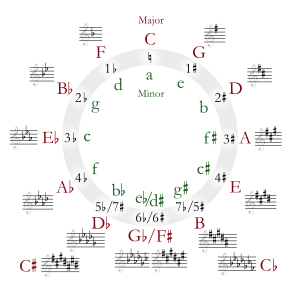Major scale facts for kids
The major scale is a very important type of scale in music theory. It's often called the Ionian scale. Think of it as a set of seven different notes that sound bright and happy. After these seven notes, the eighth note is the same as the first, just an octave higher.
You might know these notes as "Do, Re, Mi, Fa, Sol, La, Ti, Do" from solfege. The easiest major scale to play, especially on a piano, is C major. It's special because it uses only the white keys on the keyboard and doesn't need any sharps or flats.
Contents
How Major Scales Are Built
Every major scale follows a specific pattern of steps between its notes. Imagine moving from one note to the next. These steps are either a "whole step" (like moving from C to D on a piano) or a "half step" (like moving from E to F).
The pattern for a major scale is:
- Whole step
- Whole step
- Half step
- Whole step
- Whole step
- Whole step
- Half step
This pattern is why all major scales sound similar, even when they start on different notes. In Western music, scales don't skip lines or spaces on the music staff. Also, a key signature will only have sharps or flats, never both.
Names of Scale Notes
Each note in a major scale has a special name based on its position. These names help musicians talk about how notes relate to each other:
- 1st note – Tonic: This is the "home" note, the most important one.
- 2nd note – Supertonic
- 3rd note – Mediant
- 4th note – Subdominant
- 5th note – Dominant
- 6th note – Submediant
- 7th note – Leading Tone
- 8th note – Tonic (or Octave): The same as the first note, but higher.
The Circle of Fifths
The Circle of Fifths is a cool way to see how all the different major (and minor) scales are connected. Johann David Heinichen first wrote about it in 1728.
Look at the circle:
- Starting from C major at the top (which has no sharps or flats).
- As you go clockwise, each new key adds one sharp.
- As you go counterclockwise, each new key adds one flat.
The numbers inside the circle show how many sharps or flats each key has. Sometimes, two keys can sound the same but be spelled differently, like F-sharp major and G-flat major. These are called enharmonic relationships.
Why Major Scales Sound Happy
Major scales are used a lot in Western music. They often sound "happy" or "bright" because of how their notes vibrate together. This has to do with something called the harmonic series, which is about how sounds naturally combine. The way the notes in a major scale fit together creates a strong, pleasing sound.
Related Music Topics
- Minor scale
- Enharmonic
- Equal temperament
- Major and minor
- Music theory
Images for kids
| Diatonic Scales and Keys | |||||||||||||||||||||||||||||||||||||||||||||||||||||||
|---|---|---|---|---|---|---|---|---|---|---|---|---|---|---|---|---|---|---|---|---|---|---|---|---|---|---|---|---|---|---|---|---|---|---|---|---|---|---|---|---|---|---|---|---|---|---|---|---|---|---|---|---|---|---|---|
|
|||||||||||||||||||||||||||||||||||||||||||||||||||||||
| The table shows the number of sharps or flats in each scale. Minor scales are written in lower case. | |||||||||||||||||||||||||||||||||||||||||||||||||||||||




